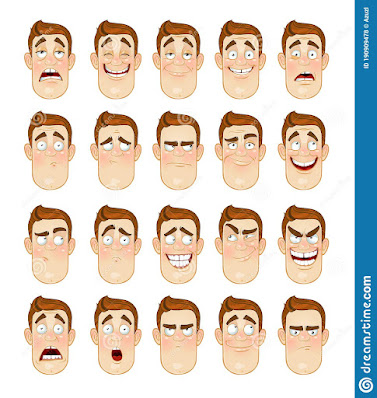Today I did the research on Emotions. Emotions play a vital role in animation because they help animators to convey the thoughts, emotions, and personalities of their characters. Emotions are expressed in animation in a variety of ways. They are expressions, movement, color, sound, etc. My research was focused on expressions because my theme is expressionism for my art portfolio. I did research on the following expressions.
1. Anger: Anger is a common emotion in animation, and it is frequently expressed through dramatic facial expressions, body language, and vocalizations. Characters who are angry are usually viewed as loud, violent, and forceful, with dramatic facial expressions and movements that reflect their emotional state. Animation can also show rage gradually, with characters squeezing their jaws, squinting their eyes, and having tense body language.
2. Sadness: Another feeling that is frequently portrayed in animation and can be done in a variety of ways is sadness. In some animations, sad emotions are displayed realistically through the use of slow movements, tears, and hunched shoulders. Other animations use more stylized representations of sadness, like drooping eyes, a mouth that is turned downward, or a faded shades. Characters often suppress their sadness behind an act of joy or stoicism, which can complicate their emotional path.
3. Joy: Joy is commonly described in animation by energetic movements, bright colours, and a variety of facial expressions. Characters who are happy may jump, dance, or laugh, and their faces may display wide smiles, sparkling eyes, and raised eyebrows. The energy and excitement that happy characters frequently exude can be contagious and uplift viewers.
4. Fear: In animation, fear is a normal feeling, especially in the horror or suspense genres. To express fear, animators frequently use a variety of audio and visual signs, such as tense music, low lighting, and scary sound effects. Characters who really are scared may shake, sweat, or freeze, and their faces may show widening of the eyes, furrowing of the brows, or opening of the lips. To increase the viewers' fear, animators may also use quick cuts, jump scares, or sudden motions.

5. Cunning: Cunning is a complicated emotion that can be difficult to show in animation due to the fact that it frequently includes fine details and thinking skills. Cunning characters could utilize trickery, manipulation, or cunningness to accomplish their objectives. To effectively convey cunning behaviour, animators may also rely on dialogue and narrative structure in addition to visual clues like raised eyebrows, sly grins, or sideways glances.
6. Confusion: Confusion is a difficult emotion to illustrate in animation because it frequently includes a variety of inner thoughts and feelings. To clearly explain confusion, animators may use visual clues like raised eyebrows, tilted heads, or a furrowed brow in addition to dialogue and narrative structure. To give viewers a feeling of confusion or uncertainty, animators may occasionally use surreal or dreamlike imagery.
Overall, animators use a variety of methods to successfully express emotions, which are an important element of animation. These methods enable artists to produce characters that are attractive, interesting, and emotionally impactful.







Comments
Post a Comment